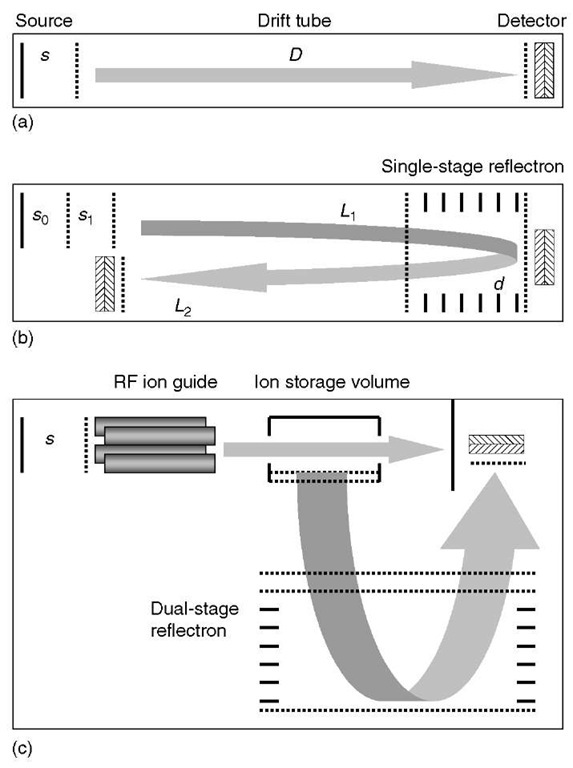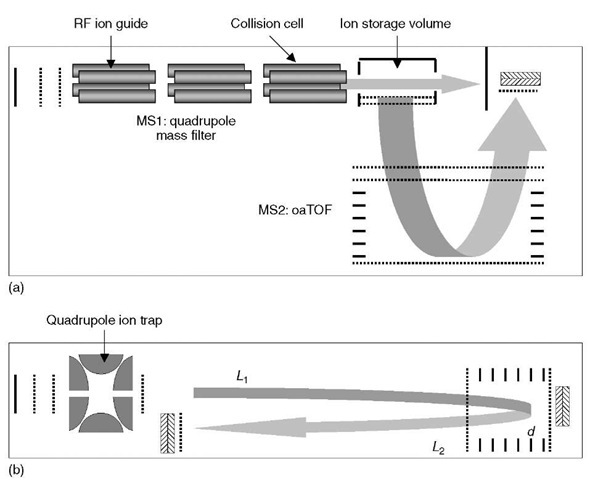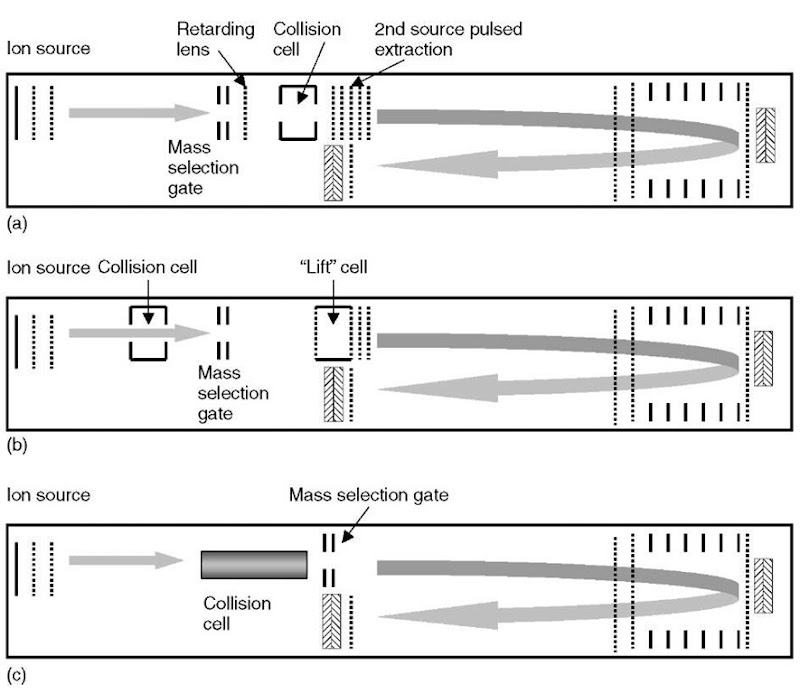1. Introduction
Time-of-flight (TOF) mass spectrometers were introduced in the 1940s (Stephens, 1946; Cameron and Eggers, 1948) and commercialized in 1955 (Wiley and McLaren, 1955). Regarded for many years as instruments with low mass range and low resolving power, TOF mass spectrometers were “rediscovered” following the introduction of ionization techniques capable of ionizing biological macromolecules including proteins and peptides, oligosaccharides, glycolipids and other glycocon-jugates, and polynucleotides. Thus, they have become important for proteomics not only in their ability to obtain molecular weights of intact proteins but also for obtaining amino acid sequences of peptides and for locating and characterizing posttranslational modifications.
2. Mass analysis and mass range
The basic TOF mass spectrometer consists of a small source region s, a longer drift length D and a detector (Figure 1a). Ions are formed in the source by any number of ionization techniques that have included electron ionization (EI) (Wiley and McLaren, 1955), chemical ionization (CI) (Futrell et al., 1968), plasma desorption mass spectrometer (PDMS) (Torgerson etal., 1974), laser desorption (LD) (Van Breemen et al., 1983), matrix-assisted laser desorption/ionization (MALDI) (Karas and Hillenkamp, 1988; Tanaka etal., 1988), and electrospray ionization (ESI) (Verentchikov et al., 1994). Ions of all masses m are then accelerated as they exit the source to final kinetic energies 1 mv2 = eV, where e is the charge on an electron and V is the voltage across the source. The ions then travel through a drift length at velocities v, which are constant but different for each mass, before striking the detector. The TOF for an ion is then given by
In theory, the mass range of such an instrument is unlimited. For current instruments using MALDI, detectors limit the mass range, as the efficiency for conversion of incoming ions to an electron cascade by electron multipliers and channel plate detectors depends upon ion velocity. That velocity is slower for higher mass ions and is the reason that current instruments operate at high (generally 20 kV) accelerating voltages. At the same time, cryo-cooled superconducting tunneling junction (SJT) (Hilton et al., 1998) detectors are now providing megadalton detection, but at lower time resolution.
Figure 1 Basic configurations of time-of-flight mass spectrometers: (a) a simple linear TOF mass analyzer with a single-stage ionization source, (b) a reflectron TOF mass analyzer with a dual-stage ion extraction source, and (c) an orthogonal acceleration mass analyzer with a quadrupole ion guide and a dual-stage reflectron
3. Spatial, energy distributions and mass resolution
The expression for mass resolving power: m/Am = t/2At indicates that this will be only as good as our ability to parse the time measurement into very small time intervals. The boxcar method used by early commercial instruments (which enabled recording of only one time interval in each TOF cycle) (Holland et al., 1983) was capable of resolving time intervals ranging from 10 to 40 ns. Today, fast analog-to-digital converters (transient recorders, waveform recorders, and digital oscilloscopes) have digitization rates up to 8 Gsample s-1, corresponding to time intervals of 125 ps. When single ion counting is used, time-to-digital converters (TDCs) provide an accuracy of 200-500 ps.
Mass resolution is also affected by the initial conditions of ions. For example, ions formed at different distances between the back of the source and the extraction grid will have different kinetic energies as they leave the source, and therefore different velocities and different TOFs. This is because an initial spatial distribution is effectively a different distance s, and a different energy due to acceleration eV = eEs, where E is the electric field in the source. Ions may, of course, have different kinetic energies before or as a result of ionization. This initial kinetic energy distribution U 0 means that ions will have different final energies as well: eV + U0. The effects of both of these are given in a more complex TOF equation:
The first term is the time in the source and includes the so-called turn-around time (Wiley and McLaren, 1955), since the initial velocity component along the flight path may be in the forward or reverse direction. The second term is the time in the flight tube and reflects the final energy. While the turn-around time is important in gas phase ionization methods, such as EI, it is generally not in methods such as MALDI in which ions are formed on a surface.
The effects of the initial spatial distribution are the easier of the two to correct. Ions formed about a small distance s + As will be focused to first order at a distance d = 2s from the source, the so-called space-focus plane. Because this distance is not far enough from the source to enable sufficient mass/time dispersion and achieve good resolving power, it is more common to use a dual-stage extraction source (Figure 1b), in which the field strength E1 in the second region s1 is much greater than that E0 in the first s0. In this case, the space focus is given by
where a = s0 + (£1£0)s1. In addition, it is possible to achieve better (second order) focusing for an optimal set of parameters.
4. Time-lag focusing and delayed extraction
The greatest challenge for achieving high resolving power is the simultaneous focusing of the initial spatial and energy distributions. The time-lag focusing method of Wiley and McLaren introduced a delay time between the ionizing electron beam pulse forming the ions and the extraction pulse accelerating them from the source. During that time, ions with larger forward velocity would move closer to the extraction grid, so that they would receive less energy from acceleration than slower moving ions. Prior to the development of MALDI this approach was used for infrared laser desorption (IRLD) (Van Breemen et al., 1983; Tabet and Cotter, 1984).
Laser microprobes (Hillenkamp et al., 1975) and PDMSs (Torgerson et al., 1974) relied on the fact that ions formed directly from a surface would have a very minimal spatial distribution, so that correction of the kinetic energy could be accomplished, without pulsed extraction, using a reflectron (see below). Following the introduction of MALDI7 (Karas and Hillenkamp, 1988; Tanaka et al., 1988) there was a return of interest in pulsed extraction methods (Whittal and Li, 1995; Brown and Lennon, 1995; Vestal et al., 1995), which have produced very high mass resolutions. While known commonly as delayed extraction, King et al. (1995) have termed this approach velocity-space correlated focusing because the spatial distribution at the time of the extraction pulse (which is absent initially) is derived entirely from the initial velocities (energies).
Time-lag focusing and the more recent pulsed extraction methods are generally accomplished with dual-stage extraction and are all mass dependent. Because the velocity distributions will be different for different masses, motion during the delay period will be different. Thus, either the delay time or the ratio E\/E0 is different for each mass. Over many years a number of dynamic methods have been developed, including impulse field focusing (Marable and Sanzone, 1974), postsource pulsed focusing (Kinsel and Johnston, 1989), velocity compaction (Muga, 1988), and dynamic-field focusing (Yefchak et al., 1989). Mass-correlated acceleration, developed more recently (Kovtoun et al., 2002), takes advantage of the fact that heavier ions enter the second region later than lighter ions and dynamically changes the field E1 by raising the flight tube voltage. In many cases, it is found that focusing in the middle mass range (5000-6000 Da) produces reasonable focus throughout the useful mass range for MALDI.
5. Reflectrons and postsource decay
Mamyrin and coworkers first reported their reflectron or ion mirror in 1973 (Mamyrin et al., 1973). Shown in Figure 1b, this mass analyzer incorporates a retarding electric field that reverses the direction of the ions. The device works to correct for an initial kinetic energy spread because the higher velocity ions penetrate more deeply into the reflectron and take longer to turn around. For a single-stage reflectron:
where L1 and L2 are the drift paths toward and away from the reflectron, and d is the penetration depth. The single-stage reflectron (Tang et al., 1988) provides first order energy focusing, while the dual-stage reflectron (an example is shown in Figure 1c) can provide second order focusing. A quadratic reflectron (Mamyrin, 1994) provides (in theory) infinite order focusing, that is, the flight time is independent of energy, but the nonlinear field along the center axis also includes off-axis field lines that cause divergence of the ion beam and loss of transmission.
When an ion of mass m1 originating from the source dissociates to form a fragment m2 in the flight tube, its flight time through a single-stage reflectron is
This offers the opportunity to select a given precursor ion m1 using an electronic gate in the flight tube L1 and to record the flight times of all the product ions m2, a method generally referred to as postsource decay (PSD) (Kaufmann et al., 1994). Focusing is poorer for lower mass product ions that do not approach the optimal penetration depth, a problem that is generally addressed by acquiring multiple spectral segments at reduced reflectron voltage. The curved-field reflectron (CFR) (Cornish and Cotter, 1993; Cornish and Cotter, 1994) eliminates the need for stepping the reflectron voltage, focusing the entire product ion mass range simultaneously. Though this reflectron uses a nonlinear field, it is closer to the constant field reflectron than to the quadratic, so that high ion transmission is maintained.
6. Orthogonal acceleration
The development of orthogonal acceleration (oaTOF) mass spectrometers has not only provided a means for achieving high mass resolution but has also provided the opportunity to utilize continuous ionization sources, most notably electrospray ionization. The first such instrument by Dawson and Guilhaus (1989) used an EI source and extraction into a linear TOF mass analyzer, while a later instrument by Mirgorodskaya etal. (1994) used an ESI source with a reflectron. Essential to the operation of the instrument (and to its ultimate mass resolution) is the collimation of the ion beam into a storage volume (Figure 1c) so that the remaining component of the velocity spread is directed along a single axis. Ions are then extracted orthogonal to that axis, using space focusing to correct for any width in the collimated beam. While a collimated beam can be achieved by passing the beam through a small orifice, much better transmission can be achieved using a quadrupole, hexapole, or octapole ion guide (Krutchinsky et al., 1998). With such a configuration, the mass analyzer is effectively isolated from the source and has no memory of the initial conditions of the ions. Thus, multiple sources can be used, as can atmospheric pressure sources such as electrospray and atmospheric pressure MALDI (AP MALDI) (Laiko et al., 2000).
Figure 2 Hybrid instruments: (a) a tandem quadrupole/time-of-flight mass spectrometer with an RF ion guide and collision chamber, and (b) a tandem ion trap/time-of-flight mass spectrometer
7. Hybrid instruments
The development of oaTOF mass spectrometers has provided the opportunity for a very successful tandem (hybrid) configuration that combines a quadrupole mass analyzer in the first stage and an orthogonal TOF as the second mass analyzer (Figure 2a) (Shevchenko et al., 1997; see also Article 10, Hybrid MS, Volume 5). In a tandem experiment, the first mass analyzer is generally used to pass a precursor mass while the second mass analyzer scans its product ion spectrum; thus, the quadrupole is an appropriate mass filter as the first stage while the TOF analyzer provides the multichannel advantage for recording the product ion spectrum. The mass/charge range of quadrupoles is more limited than the TOF, but is nicely compatible with the multiply charged ions from an electrospray source, which it accommodates using an RF ion guide as described above. An additional quadrupole provides a low energy collision-induced dissociation (CID) chamber for inducing fragmentation. Because fragmentation of multiple-charged ions is generally accompanied by charge reduction, product ions may have considerably higher m/z than their precursors, but this is easily accommodated by the TOF analyzer. An additional advantage is that selection of the precursor ion mass is much better than it is on the TOF/TOF instruments described below.
A configuration utilizing an electrostatic ion trap with the TOF mass spectrometer was introduced by Chien and Lubman (1994), and was also intended to provide compatibility between a continuous beam ESI source and the pulsed TOF mass analyzer. A trapTOF instrument with a quadratic reflectron was reported by Doroshenko and Cotter (1998). An advantage of the combined ion trap/TOF (Figure 2b) is that one can carry out MSn analyses. While this is possible on an ion trap alone, the recorded spectrum at any stage of MSn on the ion trap/TOF is always a TOF spectrum with higher mass resolution than can be obtained on the trap.
8. Tandem time-of-flight mass spectrometers
The difficulties inherent in stepping the reflectron voltage for PSD, as well as an interest in providing collision-induced dissociation of larger singly charged ions, has motivated the development of tandem TOF (or TOF/TOF) mass spectrometers. Such instruments are not entirely new; a very simple linear system designed by Jardine et al. (1992) used a voltage step after the collision cell to differentiate the flight times of the product ions. Beussman et al. (1995) and Cotter and Cornish (1993) both reported instruments using two reflectrons in a Z geometry in 1993. In the first instrument, photodissociation of the precursor ion was followed by additional acceleration of the product ions to accommodate the bandwidth of the reflectron; in the latter, pulsed CID was followed by a CFR to enable focusing of the product ions.
The most recent approaches to TOF/TOF design use a linear, pulsed extraction first analyzer, a mass selection gate at (or near) the space-velocity focus point, a collision chamber, and a second reflectron mass analyzer (Figure 3). These instruments differ in how they address the focusing of product ions in the reflectron. Specifically, precursor ions of mass m1 produce product ions m2 whose kinetic energies are proportional to their masses: (m2/mi) eV. Thus, product ion energies can range from the precursor ion energy (typically 20keV) to a few eV, while single and dual-stage reflectrons focus only a fraction of that energy range. In one configuration (Figure 3a), precursor ions are decelerated to 2keV prior to collision. After the collision, the product ions are pulse extracted from (effectively) a second source, which reaccelerates the ions by an additional 18keV, so that ions with an energy range from 18 to 20 keV enter the reflectron (Medzihradszky et al., 2000). In a second approach (Figure 3b), precursor ions leave the source and enter the collision chamber at 8 keV and are not decelerated. The product ions (still traveling at the same velocity) enter a field-free lift cell whose potential is raised (by 19 kV) while the ions are in residence (Suckau et al., 2003). A third configuration (Figure 3c) uses a CFR to focus all the product ions resulting from 20-keV collisions, obviating the need for decelerating, reextracting, or lifting the product ions (Iltchenko et al., 2004). These configurations provide much-improved approaches compared with stepping of the reflectron voltage, plus the opportunity to locate mass selection at the space-velocity focus point and to carry out CID between the mass analyzers. Interestingly, MS/MS spectra on these instruments are not very different with and without a collision gas, which suggests that the processes are fundamentally the same: PSD or laser induced dissociation producing high internal energies, with fragmentation then aided by the collisions. At the same time, one observes the appearance of (or increases in) internal and single amino acid ions, which may result from a second, collision-induced fragmentation (Medzihradszky et al., 2000; Iltchenko et al., 2004; see also Article 4, Interpreting tandem mass spectra of peptides, Volume 5).
Figure 3 Tandem time-of-flight mass spectrometers using different approaches for focusing product ions: (a) deceleration prior to collision followed by reacceleration of product ions, (b) potential lifting of product ions, and (c) focusing by a curved-field reflectron
9. Future prospects
There is considerable interest in the development of compact, field-portable and/or miniaturized mass spectrometers; in this area, the TOF offers the possibility for retaining the same high mass range as its larger, high-performance counterparts (English etal., 2003). While such instruments are expected to play a significant future role in proteomics-based, point-of-care diagnostics, it is also clear that there is currently an increasing demand for high-performance instrument for the identification and validation of biomarkers. This includes both high mass resolution and MS/MS capabilities.








